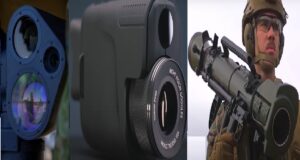Fractl Laser 500 Meter Drone Zapper is a Game-Changer for Defense (Here’s Why)
Australia tests powerful laser weapon to shoot down drones with pinpoint accuracy. This suitcase-sized laser can disable drones from over a kilometer away and is easy to use, offering a silent and ammo-unlimited advantage over traditional weapons.
CONTENTS: Fractl Laser 500 Meter Drone Zapper is a Game-Changer for Defense

Australia tests powerful anti-drone laser
Fractl Laser 500 Meter Drone Zapper is a Game-Changer for Defense
Australia recently conducted its first test of a groundbreaking laser weapon designed to effectively neutralize drones with remarkable precision. Known as the Fractl Portable High Energy Laser, this system is touted as the world’s most powerful portable laser of its kind. The test took place at the Puckapunyal range, a prominent training facility for the Australian army, in May.
According to the Australian Defence Force (ADF), the Fractl laser is capable of tracking targets as small as a 10-cent coin moving at speeds up to 62 mph (100 km/h) from a significant distance. Moreover, it possesses sufficient energy to cut through steel. This marks a significant advancement in ADF’s efforts to bolster its arsenal against unmanned aerial vehicles (UAVs), highlighting the weapon’s potential in enhancing Australia’s defensive capabilities.
High-tech laser zaps drones for intel
AIM Defence, a Melbourne-based company, has developed a compact, suitcase-sized laser known as the Fractl laser, which operates at the speed of light akin to a blowtorch. Claimed to be equipped with the world’s most advanced tracking and optics system, this technology allows the laser to accurately target drones moving at speeds up to 62 mph (100 km/h) from distances of 0.62 miles (1 kilometer).
The laser beam, as precise as the size of a dime, can effectively disable critical components of the drone such as its rotors, wiring, and camera. This capability facilitates the retrieval of the drone for forensic analysis and operational intelligence purposes.
Corporal Patrick Flanagan of the Australian Defence Force (ADF) described the operation of the laser as akin to a video game: users initiate tracking with a button press, and the system autonomously directs the laser beam to the target upon another command.
Portable laser zaps drones cheaply
According to the Australian Defence Force (ADF), operators can swiftly adjust the Fractl laser’s aim using just an index finger, allowing them to target the drone’s video camera, center mass, or individual propellers with ease. Disabling the camera takes mere seconds, while incapacitating a propeller requires only two to three seconds.
The system is engineered for seamless integration into existing frameworks, reducing operator burden and improving response times. It is highly versatile, offering options for both battery and AC power. Remarkably portable, the entire field-ready unit weighs less than 110 pounds (50 kilograms), ensuring it can be effortlessly deployed across various operational environments.
AIM Defence claims that the Fractl laser is significantly smaller and more cost-effective compared to other laser systems available on the market, positioning it as a highly capable and economical solution for drone defense.
Laser zaps drones, silent ammo advantage
During a recent demonstration at Puckapunyal, the deployable prototype of the advanced laser system successfully disabled a drone at a distance of 500 meters through a process known as ‘hard kill’. While the laser’s operational range is somewhat constrained by its power supply, it has previously engaged drones up to 1 kilometer away.
AIM Defence officials emphasized the significance of this demonstration, marking progress towards achieving ranges comparable to their one-micron system, which reaches 1.5 kilometers for counter-sensor operations and 1 kilometer for direct engagement.
In contrast to traditional weapons, the silent and stationary nature of directed-energy counter-UAS systems provides a stark advantage. In comparative demonstrations alongside armored crews, these laser weapons proved highly effective, requiring minimal ammunition and allowing for precise engagement with minimal margin for error.
Australian Defence Force (ADF) officials underscored the benefit of laser weapons’ nearly limitless ammunition capacity, reliant solely on available power. They also highlighted the importance of modern fire control systems in effectively tracking and engaging drones of varying sizes and configurations.
Eli Lea from the Robotic and Autonomous Systems Implementation and Coordination Office emphasized the necessity of employing a diverse range of tools to counter the evolving threat posed by drones, particularly emphasizing the challenge of targeting small multi-rotor UAVs. He stressed that directed-energy weapons capable of detecting, tracking, and engaging such targets are crucial components within this arsenal.
Check out TimesWordle.com for all the latest news
You must be logged in to post a comment.